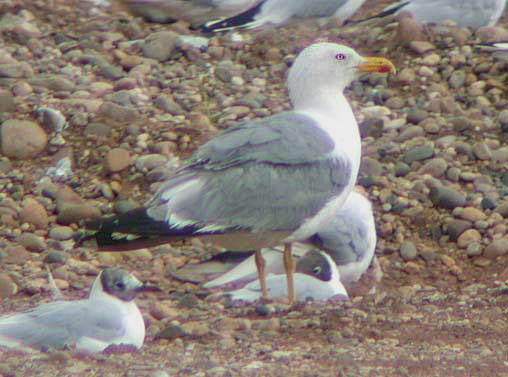Yellow-legged Gull Larus michahellisAdult, July 20th 2003, Staffordshire |

© A. R. Dean
Compared with Herring Gull, Yellow-legged Gull is on average more elegant, with a fuller, squarer, more flat-topped head-shape and relatively longer wings and legs. The upperparts are a darker shade of grey than Herring Gull, obviously so compared with British argenteus though approached by darker examples of nominate argentatus. The wing-tip pattern displays more black and less white than Herring Gull. There is generally black on six, sometimes seven, outermost primaries. The black band across the tip of p5 is generally quite thick and unbroken, so that the extent of black on this primary and on p6 is more extensive than on nominate argentatus. The pattern of black is not, however, so distinct from that of argenteus but that race has relatively pale grey upperparts so confusion should generally not arise. In winter, the head of michahellis remains relatively white and unstreaked compared with the generally well-streaked and messy head-pattern of Herring Gull, though when freshly moulted in autumn michahellis often does show limited head-streaking. This tends to take the form of rather neat streaking around the eye and across the centre of the crown, and this in itself can be quite distinctive. The orbital ring of Yellow-legged Gull is generally blood-red, creating a darker-eyed appearance compared with Herring Gull. In adults the legs are a rich yellow, though less intense during the winter months and throughout the year in sub-adult birds. The yellow legs in combination with the relatively dark grey upperparts are often the features which initially attract attention on a standing bird. Note, however, that Herring Gulls sometimes display yellow-legs, particularly individuals of the nominate form from certain areas of Scandinavia and eastern Baltic region, so it is essential to use a full suite of characters when identifying Yellow-legged Gull. The timing of the full post-breeding moult is somewhat earlier than in Herring Gull, reflecting it's slightly earlier breeding season. Birds appearing in Britain in late June and early July generally show obvious signs of primary moult, with one or more central primaries 'missing' (in fact present but only part grown or just out of 'pin' and so hidden by overlapping 'inner' primaries). When preening, the state of moult and the pattern of the primary tips can often be determined.
The photo above shows a classic adult michahellis of the type arriving in Britain in late summer from the Mediterranean basin. Compare with individual photographed on November 27th. Note relatively dark shade of grey on upperparts compared with Herring Gull. Also, rich yellow legs and coral red orbital ring to eye. These are features of all 'forms' of Yellow-legged Gull. Mediterranean birds typically display a headshape as in this individual: comprising a distinct forehead sloping up at 45o to flat-topped crown, and rather 'vertical' nape. Bill sturdy with obvious gonys and 'hooked' tip. Wing-moult in progress, as expected in mid July, with some inner/central primaries, tertials and rear scapulars missing.
|
|
Home |
Mediterranean
| Laughing |
Franklin's |
Little |
Sabine's |
Bonaparte's |
Black-headed |
Ring-billed | Common |
Lesser Black-backed | |